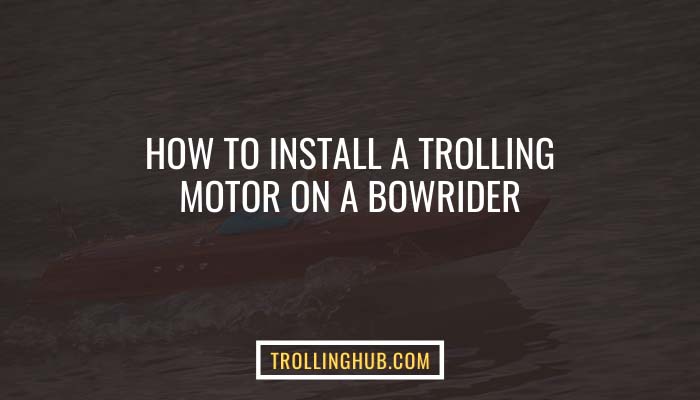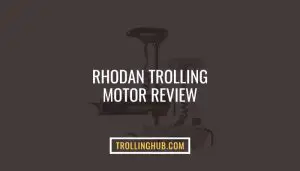
If you don’t want to run your boat’s loud outboard engine, trolling motors are the ideal tool for moving and maneuvering your bowrider. Trolling motors, commonly positioned at the bow or transom, are battery-powered and operated by hand, foot pedals, or wireless connectivity. So, it’s essential to know how to install a trolling motor on a bowrider.
Trolling motor installation is quite simple. Set the motor in the operational position to determine where to attach the base pad on the bow. Then you must perform a few fundamental steps.
We’ll teach you more about how to install a trolling motor on the bowrider and make life simpler for you to do it yourself. We’ll also go over some critical installation information and go into the nitty-gritty of the mounting technique. Continue reading to find out more!
Can I put a trolling motor on a bowrider?
You certainly can! In most circumstances, putting a trolling motor on a bowrider is straightforward. If you’ve ever drilled a hole in the boat or made any adjustments to it, you’ll already have the necessary skills and knowledge to complete the job.
Preparation is essential for any boat endeavor. Ascertain that you have all of the necessary motor components and tools. Whenever you drill or cut anything, read and reread the directions in your handbook.
Contact a professional service facility if you are unsure if you can or choose to do it yourself. Trained experts may save you time and frustration, especially if you have a complex installation that involves changes to your boat.
Trolling Motor Mounting Types For Bowrider
Trolling motors are mainly classified into two types: Bow, and Transom mount. Each has its own set of benefits and drawbacks. Let’s discuss the best twos.
Bow Mounts
Bow mount trolling engines are the most common harsh fishing engine used by medium to large vessels. One of their most prominent benefits is that they allow substantially better control when opposed to a transom mount motor.
It is a bow position motor that pulls the boat through the water rather than pushes it from behind (as a transom-mounted does) and allows for considerably more accurate steering. A bow mount motor is an ideal solution if mobility and precision are critical.
Furthermore, bow mount motors provide a wider variety of control choices (hand, pedal, and wireless control) and a more conspicuous set of features than transom mount engines. Bow mount engines are more costly than transom mount motors despite their attractiveness.
However, they are more challenging to install and occupy more deck space than equivalent transom mount motors. A flat deck and enough room on the front of the boat are required to establish a bow mount motor.
Transom Mounts
Transom mount motors are widely known with smaller boats because they are easier to set up than bow mount motors. While bow mounts require a plate to be drilled into the boat’s bow, transom mounts attach to the stern with a simple clamping.
Moreover, transom mount motors are much cheaper to manipulate from the bottom of the boat and do not clog up the deck with legs or wires, as bow mount motors sometimes do. Smaller vessels, such as canoes, are typically better off with transom mounts. They are often less expensive than bow mounts due to their more simplistic construction.
How To Install A Trolling Motor On A Bowrider?
A trolling motor is a must-have piece of boating equipment for particular boating activities like troll fishing. However, mounting a trolling motor might become a difficult task due to many factors to consider. Let’s take it one step at a time and learn how to install Bow mount and Transom mount trolling motors.
Equipment Needed For Installing a Trolling Motor On A Bowrider
The majority of the resources you will require from the entire process are listed below. Depending on the motor you purchase, you can manufacture one or more extra parts.
Here’s what you’ll need
- Drill bits and an electric drills
- Wrench set
- Screwdriver with a flat blade
- A Phillips screwdriver
- Ties made of cable
Before going to the further steps, collect all those essential tools. It will make the whole process easy and hassle-free.
Bow Mount
Bow mounts are generally easy to control. Even the installation process is simple. So, let’s have a look at them!
1st Step: Separate and Place the Mount Base
You should fasten the base to deploy your trolling motor, propel the kayak through the sea, and stow it when you are not using it. Choose a location where the installation bolts can pass via the deck while remaining far enough away from your hull to accommodate the nuts.
2nd Step: Seal and Drill Holes in the Deck
To mark the holes as a template, use your mount base. You can use a sharp drill bit for the drill and, if required, countersink.
3rd Step: Screw your mounting bolts
Now, put the rubber washer across each hole before gently placing the mounting base on the washers. Thread the bolts through the floor and spots. Thread and tighten washers and nuts.
Final Step: Secure your Motor to its Mounting Base
If you fish in choppy water, the engine’s top portion should be about 12″ under the water or even more profound.
Transom Mount
They are widely popular and much easier to set up than a bow mount. So, explore the ways to install it.
Initial Step: Turn the clamps counterclockwise to open them
Transom-mounts are typically held in position by two clamps. So, turn the clamps and open them.
Step 2: Carefully position the motor over your transom
You should lower the engine until the mounting bracket’s top is teeming with your transom. Do this task with caution.
Step 3: Adjust the Clamps
Turn the clamps clockwise after setting the motor to the maximum. Be careful that the clamps shouldn’t be overtight. It will reduce your fishing experience.
Final Step: Adjust the Motor Depth
All transom mounting motors feature a ring, clip, or another method for adjusting the depth. To avoid propeller cavitation and noise, ensure it is around 10″ deep.
Maintenance Tips
It is essential to regularly execute a few maintenance activities to keep your trolling motor in excellent working order. You must clean your trolling motor regularly with hot water and soap, cleaning any sand, grime, or dried plants. Also, ensure that all screws & bolts are correctly tightened.
Pull the prop and examine the shaft for any blockages. Blockages can be risky while fishing in the deep sea. You can check out this article on how to balance a trolling motor prop. Watch out for a fishing line twisted around it before heading onto the sea.
Final Verdict
In addition, inspect the propeller for any damage. Finally, inspect the battery links for corrosion regularly.
Say goodbye to continuous paddling! Add a trolling motor to your boat to make it simpler to navigate calm seas and enjoy fishing. We hope our installation guide will be helpful to you.
Before taking it out on the lake, ensure that everything is installed correctly and fastened. It’s all about your sailing experience. However, you must go for the one that makes it simpler for you to enjoy your boating hobbies, whether it’s troll fishing or simply going for a leisurely ride.



